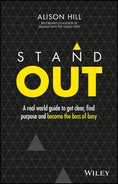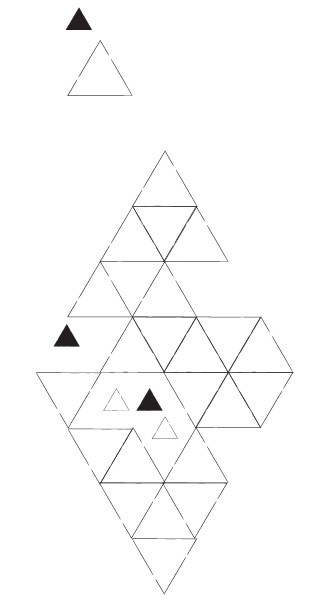
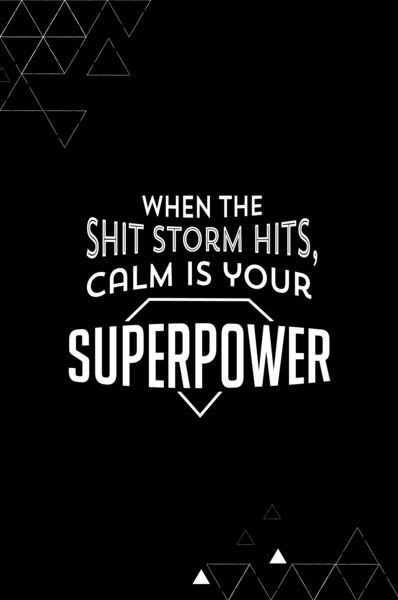

CHAPTER 02
KNOW YOUR STATE
Purpose and progress are the critical components required to transition out of overwhelm. But when we look at these components in closer detail, it's how purpose and progress interact that becomes really interesting.
First, have a look at figure 2.1, which shows the first of the four states of the Stand Out Model™.
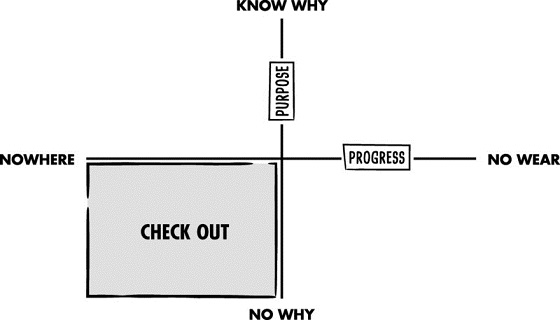
Figure 2.1: Check Out
If you're down in the bottom left quadrant, you're not making any progress at all and have no connection to why. This is where we Check Out. You may recognise this state if you find yourself on Monday morning literally counting down the seconds until Friday afternoon, or if you spend more time on your smart phone than actually being smart.
Often what happens in this state, though, is that we get into action in order to move forward and feel like we're making progress. We shift over to the bottom right side of the quadrant (see figure 2.2), where we're absolutely making progress, kicking goals, winning awards and being recognised by other people as doing amazing stuff — but somehow we've kind of disconnected from why we started all this progress in the first place.
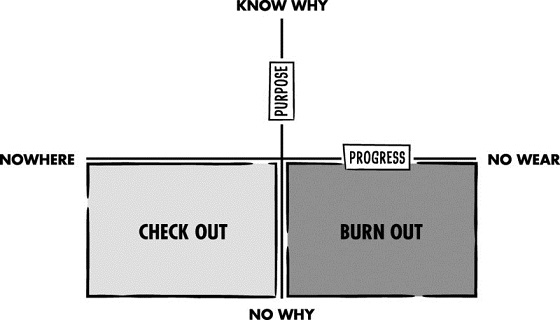
Figure 2.2: Burn Out
This space is where we Burn Out. You might know that you're in Burn Out when the thing that you used to love now frustrates you; when your breakfast is made of coffee, and your lunch is pretty similar; when you've absolutely mastered the art of not only keeping the car running when you drop your kids off at school, but also actually keeping it moving and shoving them out as you go. It's efficiency, right?
Shifting up to the top left quadrant (see figure 2.3) is where we are connected to our purpose, what we want to do and why we want to do it, but we're not feeling like we've got a sense of progress. This is where we Freak Out, because we feel like we have to let go of who we are in order to get moving. We start to even doubt ourselves in this space. We get scared of telling our friends what we want to do, because they've heard it so many times that they're going, ‘Really?? I'm not seeing anything happening from here'. Part of our frustration is we feel like we have to let go or lose part of ourselves in order to achieve success.

Figure 2.3: Freak Out
The sweet spot is in the top right quadrant (see figure 2.4, overleaf), when we can get the combination of both purpose and progress. It's in this place that we're connected to why we're doing what we're doing, and we feel like we're making progress — and this is where we completely Stand Out.
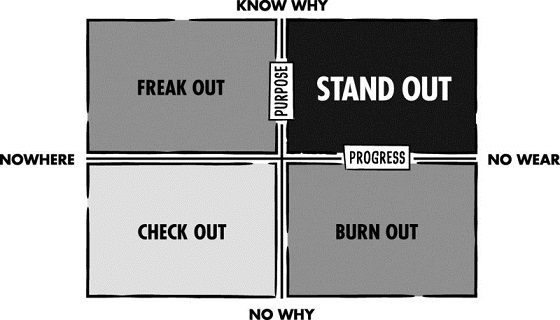
Figure 2.4: Stand Out Model™
Standing out isn't about being famous or something you're not. It's about putting aside the expectations, getting clear on your decisions and having a pathway to move towards what matters most. And it's the swagger, self-confidence and assurance of being in that space and standing out.
Where do you think you've been for the past couple of months? Do you look at any of the areas and think, Hey, I recognise myself in that? You may well be thinking, I've been in all of those in about an hour. You are not alone, and we can shift and change between these states.
FINDING ONE PURPOSE IS NOT YOUR PURSUIT
Before discussing purpose in any more detail, I'd like to look at a common misconception. We've been sold that you just need to find that one purpose you were put on this earth to do — the one thing you were made for. This pursuit drags us away from exploring an equally important question: how can I find purpose in what I'm doing right here and now?
The thing is, human beings are incredibly adaptable — indeed, our whole existence depends upon it. If you'd been born 50 years ago, your purpose and passion would be completely different from what it is now, because the opportunities and environment would have been different. If you had been born in another country, your purpose would be different again.
Your goal is not about trying to find one thing that you were put on this Earth to do — and you certainly shouldn't feel like until you find this goal you are in a holding pattern.
Best-selling author Jeff Goins tackled this in his book The Art of Work. Jeff describes how we all have portfolio lives, and where we are right now is just a part of our portfolio. Whatever you are doing now is part of the evolution of your life. The next part of your portfolio might involve you sailing around the world, or taking up tap-dancing (maybe even both!).
Boredom presents you with the opportunity to reignite in a different direction, or take a deeper dive to another level of mastery. When we see this opportunity as exciting and get curious about ‘what next?', we realise that we are in charge of our portfolio.
So your aim is not about just finding one purpose for your life. It's about recognising what is happening in your life right at this point and what's going on for you, and being curious about what parts of this role currently grab your attention. What do you want to dial up even more? Whatever that is, follow that rabbit hole.
WHAT'S EACH STATE COSTING YOU?
Each of the four states comes at a cost — as shown in figure 2.5.
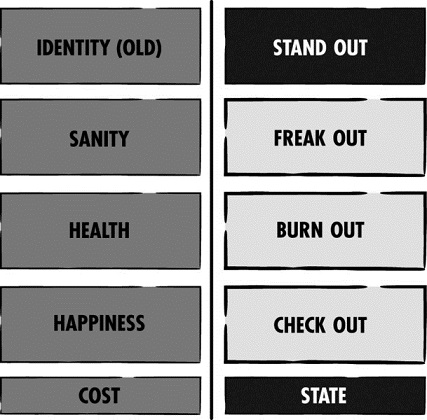
Figure 2.5: costs in the four states
When we're in Check Out, the cost is to our happiness. We're in Check Out when it's Monday morning at work and we don't just count down the days, we count down the seconds until Friday afternoon; when our best skill is flying under the radar; when we find ourselves sitting on the couch with a bucket of ice-cream watching 20 hours of Sex in the City reruns.1 As we disconnect from what's going on, we start to lose a sense of self, and happiness is the casualty.
The cost to being in Burn Out is to our health, because the first three things to go downhill when we're working at a rapid pace are sleep, nutrition and exercise. We burn the candle at both ends, swapping sleep for worry and grabbing the most convenient food options available — and the only sprint we do is to catch the lift. Our sleep, nutrition and exercise drop off despite the fact that these are the three things needed for sustained energy and vitality.
The cost to being in Freak Out is to our sanity — not in a clinical sense, but we do start to doubt ourselves. The doubt arises because we're not sure if we're doing the right thing or if we're on the right path, and we question our intuition, which is the very thing that ignites us. The reason we doubt our gut instinct and connection to purpose is because we can't see any progress — nothing is happening.
Being in Stand Out also comes with a cost, and this cost is having to let go of our old identity, and shed the skin of the person we've been so that we can embrace who we want to become. Identities are strong and we hold onto them long after they continue to serve us. Perhaps you tell yourself, ‘I'm not a runner/writer/musician/leader/_________ (insert your word)', ‘I'm always shy meeting new people', ‘I'll never be able to speak in front of people'. The stories we tell ourselves form the identities that we hold onto. Recognising these stories and the identities attached to them, and then letting them go and being brave enough to tell a different story is the cost of being in Stand Out.
When Darren and I started our business we had two very young children and my focus was working on the backend of the business, while Darren presented sessions, delivered keynote speeches and was the face of the company. The backend support had become my identity — until our children reached the ages of four and six, when it was time for me to move into a role of presenting programs and keynotes. I remember getting frustrated at myself for spending so much time fluffing around, and not feeling like I was getting anywhere. I was worrying about the colour and font on my program flyer (irrelevant), rather than actually picking up the phone to talk to clients about what I had to offer (important). One morning I wrote on the whiteboard above my desk, ‘Do the work. Be seen'. To now be the person who would ‘be seen' was bloody scary, and to become this person I needed to let go of the identity of being behind the scenes.
For a lot of people, this identity change can be such a scary process that they prefer to stay in any of the other states rather than have the courage to let go of their old identity.
How do you see these costs playing out in your life?
WHAT YOU NEED TO INVEST IN FOR EACH STATE
While each of the four states comes with a cost, they also involve areas you can invest in that will bring you back to focus. These costs and investments are outlined in figure 2.6.
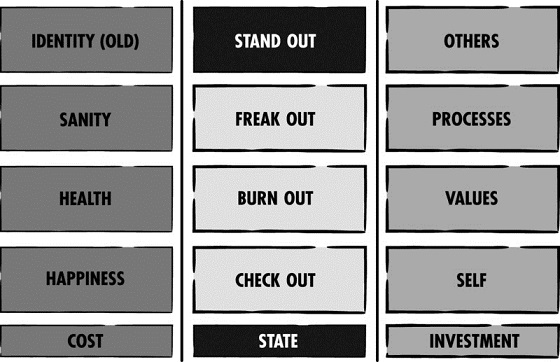
Figure 2.6: costs and investments in the four states
Being in Check Out requires individuals to invest in self — that is, to come to looking after the mental, physical, psychological, emotional and spiritual parts of self. Recognising that it's not selfish to prioritise our needs but actually necessary to be able to give the best of ourselves to others.
During the state of Burn Out, the focus is on investing in values. Values have been shown to make a critical difference within the workplace — from leadership to recruitment to strategic planning. Investing in values is about exploring what is important to you, right here and now.
Discerning between the ‘should' and the ‘would' are at the heart of this stage. Investing in becoming clearer about what your values are, and in having the language to describe these will mean that other people's expectations don't become a priority. This will give you direction for action.
Being clear on what's important to us, and having processes in place in order to turn up, inspire and give the best to others is key to being in Stand Out.
Being in Freak Out requires an investment in processes. Being connected to purpose is not enough without that action bringing traction — in other words, this is the business end that requires the work to be done. There's nothing sexy about it, it just needs to get done. Get clear on whom you are going to call, sit down and write the chapter of that book, focus on what needs to happen next and put it in a process.
When we're in Stand Out we get to invest in others. Often what happens when we're in other states, though, is we spend a lot of time putting others first, and ignoring or putting our needs off. Instead, investing in others requires the building blocks of continually investing in self, values and processes. Investing in others without these building blocks means we don't turn up as our best selves, and we don't give others the best of what's possible. Being clear on what's important to us, and having processes in place in order to turn up, inspire and give the best to others is key to being in Stand Out.
THE PURSUIT OF CALM (NOT HAPPINESS)
Mountains of books, billions of words published online, and hours of research have been poured into the pursuit of happiness (not to mention the hours Will Smith put into his role in the movie The Pursuit of Happyness). And you may be looking to work out of the states of Check Out, Burn Out and Freak Out so you can feel happier.
Research from the likes of Dr Russ Harris and journalist Oliver Burkeman, however, suggests that pursuing happiness is not the goal that most of us desire. In fact, their research suggests that not only is this pursuit draining, but also constant happiness, if we achieved it, is not something we would actually enjoy. This is because experiencing suffering, challenges and frustrations is a key part of what it means to be human.
Rather than happiness, what the modern era is really desperately searching for is the feeling of calm. Not a yoga pose calm, or on top of a mountain, next to a babbling brook of unicorn tears calm, but calm among the chaos.
The person who has the greatest influence is the one who can breathe deep in a crisis. Among the whirlwind of whinging, the juggling of judgements and the catchcries of craziness, what we're really wondering is how we can be that custodian — the one constantly pursuing calm.
So your mission (should you choose to accept it) is to now become the Custodian of Calm — even in a shitstorm. The chaos is not going away. Waiting for a time when the pressure will be off is false hope. You have to find space for calm among the busyness. The actions outlined in the remaining chapters in this book aim to reconnect you back to what's important and offer tips to come back to calm even among the chaos.
Remember: two big things are often missing from our conversations, and we need to skyrocket these to the front:
- Why this?
- What's next?
Closing the gap between why and what for those actions that are mission-critical is key to reaching the state of Stand Out. This pursuit comes when we first acknowledge what state we are currently in (Check Out, Burn Out, Freak Out or Stand Out), what being in this state is costing us (happiness, health, sanity or our old identity) and where we now need to invest (in self, values, processes or others).
 GET YOUR SH*T TOGETHER WRAP UP:
GET YOUR SH*T TOGETHER WRAP UP:
- You can't change what you don't acknowledge. Be clear on what your roadblocks are.
- Productivity is not the answer. Focus instead on what you are bringing into being, that thing that has your fingerprint on it.
- Fear of criticism is not a reason to stop.
- When we have a strong ‘why', purpose drives change.
- Purpose without action, though, is useless — we need to get moving. Progress is the second driver of change.
- Be real about where you are now when it comes to purpose and process, and acknowledge which state has become your default.
- Embrace the mindset of curiosity to explore where you want to be.
- Becoming clear on the costs that accompany each state gives you your motivation for change.
- Calm is your superpower among the busyness. The actions within this book serve to help you in this pursuit.
NOTE

